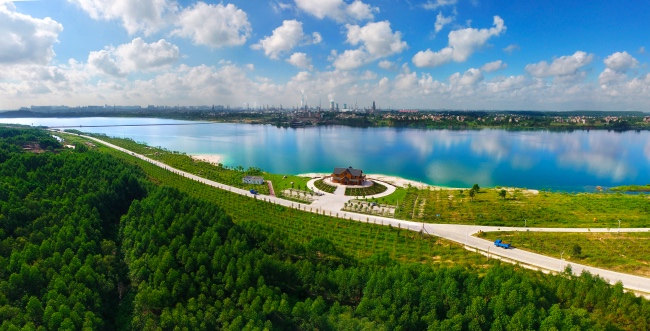Maoming, city with time-honored history
- Updated: 2021-11-22

Haoxin River in Maoming [Photo provided to guangdong.chinadaily.com.cn/maoming]
During the Spring and Autumn Period (770-476 BC) and the Warring States Period (475-221 BC), Maoming belonged to Baiyue. In the eighteenth year of the Emperor Wen Period of the Sui Dynasty (581-618), Maoming county was set up. Shilong, Wuchuan, and Maoming counties were all under the jurisdiction of Luozhou, and the prefecture government was in Shilong county (in today's Huazhou).
On Nov 2, 1949, the main leaders of the Maoming county Party Committee, the Maoming county People's Government, and the advance force of the Fourth Corps of the Second Field Army of the Chinese People's Liberation Army entered Gaozhou city to fully take over political power and liberate Maoming county. Maoming county is affiliated with the South Road Special Zone of Guangdong province.
In Sept 1950, Maoming county was affiliated with the Gaolei Administrative Region.
In Nov 1952, Maoming county was affiliated with the Western Guangdong Administrative Region.
In Feb 1956, Maoming county was affiliated with the Zhanjiang Administrative Region.
On Aug 26, 1958, Maoming industrial and mining city was established.
On March 22, 1959, the 86th meeting of the Plenary Meeting of the State Council approved the cancellation of Huaxian county and Wuchuan second county, and merged the administrative areas of the second counties into Huazhou county. Maoming and Xinyi counties were abolished, and some of the administrative areas of Maoming county were merged into Maoming. The remaining administrative areas and all the administrative areas of Xinyi county were merged into Gaozhou county.
On May 9, 1959, Maoming industrial and mining city was renamed Maoming city.
On April 1, 1961, Gaozhou county was divided into Gaozhou and Xinyi counties, and Guding, Magui, and Shenzhen of the original Xinyi county became affiliated to Gaozhou county.
On April 5, Huazhou county was divided into Huazhou and Wuchuan counties. Longshou, Lanshi and Gaozhan of the former Maoming county became affiliated to Wuchuan county, and Nansheng became affiliated to Huazhou county. Maoming city, Xinyi county, Gaozhou county, Dianbai county and Huazhou county all belong to the Zhanjiang Administrative Region.
From March to April 1967, Maoming city and four counties successively implemented military control.
On April 6, 1981, Maoming resumed the administrative system in place before the "Cultural Revolution" and cancelled the "Maoming Revolutionary Committee" and its affiliated working institutions.
In July 1983, Maoming was directly under Guangdong province. On Sept 1, the Maoming Municipal Party Committee and Municipal Government established a new leadership. In the same month, the Maoming Military Subarea was established.
On April 18, 1985, Maonan district was established based on the former urban area and suburbs of Maoming City. It governs eight towns, seven sub-districts, and a provincial economic development pilot zone.
On Nov 28, 1987, the State Council agreed to include Maoming and Dianbai county in the economic open zones. In the same year, Jintang and other towns under the jurisdiction of Maonan district and Mata and other towns under the jurisdiction of Dianbai county were listed as key satellite industrial towns in the coastal economic open zones. These towns, along with Shuidong Town, enjoy the preferential policies and treatments granted by the central government and the province.
In Oct 1988, the State Council approved Huazhou county as a coastal economic open zone and Dianbai county Shuidong Port as a port opened to the outside.
On June 18, 1992, the Nanhai Economic Development Experimental Zone was established. On July 18, it was renamed the Maoming Shuidong Economic Development Experimental Zone.
In June 1993, Gaozhou county became a county-level city.
In July 1994, Huazhou county became a county-level city.
In Sept 1995, Xinyi county became a county-level city.
On March 13, 2000, the Maogang district of Maoming city was established. The district has jurisdiction over six towns, namely Yangjiao, Poxin, Qijing, Xiaoliang, Shayuan and Nanhai. The district Government is in Nanhai town.
In 2003, a merger of villages and towns was carried out. By the end of 2011, Maoming had jurisdiction over Dianbai county and Maonan and Maogang districts, and managed the three county-level cities of Xinyi, Gaozhou and Huazhou.
On April 26, 2012, Guangdong Maoming Binhai New Area was established. The planned area of Binhai New Area is 1,688 square kilometers, including 19 towns, six sub-district offices, and high-tech industrial development zones in Maonan district, Maogang district, and Dianbai county.
In early 2014, the Dianbai county and Maogang district were merged into Dianbai district with the approval of the State Council, and Dianbai district was formally established on April 18, 2014. So far, Maoming has jurisdiction over two districts, and manages three county-level cities, Maoming Binhai New Area, Maoming High-tech Industrial Development Zone, and Shuidong Bay new city.


